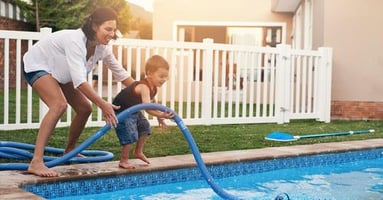Losing a little bit of water each week from evaporation is normal. Think your pool is losing more...
Pool Chemistry 101: A Guide for New Pool Owners
Owning a pool is one of life's great pleasures — backyard barbecues, refreshing swims on hot summer days, and creating memories with family and friends. But beneath all the fun is one simple truth: clear, safe pool water doesn't happen by accident. It all comes down to understanding and maintaining proper pool chemistry.
If you're a new pool owner, don't worry — this guide breaks down the essentials in a way that's easy to understand and even easier to follow. Let's dive in!
💧 Why Pool Chemistry Matters
Pool chemistry might sound technical, but it's really about keeping your water clean, safe, and enjoyable. When your water is balanced, you:
1. Keep Swimmers Safe
Balanced chemicals prevent the growth of harmful bacteria, viruses, and algae, resulting in fewer health risks and cleaner water.
2. Protect Your Pool Equipment
Corrosive or overly alkaline water can damage your filter, pump, heater, and pool lining. Balanced water extends the life of your investment.
3. Keep the Water Clear and Comfortable
Nobody wants to swim in cloudy, green, or smelly water. Proper chemistry keeps it sparkling and swim-ready.
Think of pool chemistry like brushing your teeth — it's a small habit that makes a big difference.
🧪 The 5 Key Elements of Pool Chemistry
1. Sanitizer (Usually Chlorine)
- Purpose: Kills bacteria, viruses, and algae.
- Ideal Range: 1.0 – 3.0 ppm (Standard Chlorine System)
- Ideal Range: 0.5 – 1.0 ppm (Aquasmart System)
Chlorine is the most common pool sanitizer, and for good reason — it's effective, affordable, and easy to manage. You'll find it in:
- Aquasmart Automatic Chlorinator
- Tablets (in floaters)
- Granules (dissolved into the water)
- Liquid (poured directly into the pool)
👉 Check levels often, especially after rain, heavy pool use, or hot sunny days — all of which can reduce chlorine levels quickly.
2. pH (Acidity/Alkalinity of Water)
Purpose: Affects swimmer comfort and sanitizer performance. Ideal Range: 7.2 – 7.8
Your pool's pH determines how acidic or basic the water is. Here's what can happen outside the ideal range:
Low pH (<7.2): Water becomes acidic, which can sting eyes, irritate skin, and corrode pool surfaces and equipment.
High pH (>7.8): Water becomes too basic, which can lead to cloudy water and reduce chlorine effectiveness.
📌 Use pH increasers (soda ash) or pH decreasers (muriatic acid) to stay within range.
3. Total Alkalinity (TA)
Purpose: Acts as a buffer for pH levels. Ideal Range: 80 – 120 ppm
Total alkalinity helps maintain a stable pH level. If it's too low, pH can become unstable. Too high, and pH can get stuck at the upper end of the range.
💡 To adjust:
- Raise TA: Use baking soda (sodium bicarbonate)
- Lower TA: Use muriatic acid
4. Calcium Hardness
Purpose: Protects surfaces and prevents corrosion. Ideal Range: 200 – 400 ppm
Water that's too soft (low calcium) will try to draw minerals from your pool walls or metal fixtures. Too hard (high calcium), and you'll start seeing:
- Scale buildup on tile and equipment
- Cloudy water
🧱 Especially important for plaster or concrete pools. Use calcium hardness increaser as needed, and test monthly.
5. Stabilizer (Cyanuric Acid or CYA)
Purpose: Shields chlorine from the sun's UV rays. Ideal Range: 30 – 50 ppm
Without a stabilizer, sunlight can burn off Chlorine in just a few hours. However, be cautious — excessive stabilizer can render Chlorine less effective by locking it up.
🧪 Some chlorine tablets (like trichlor) already contain stabilizer, so always check the label before adding more CYA separately.
🧫 How to Test Your Pool Water
Regular testing is the cornerstone of pool care. You can use:
✅ Test Strips – Quick, easy, and great for daily checks
✅ Liquid Test Kits – A bit more effort, but more accurate
✅ Digital Testers – The most precise (and most expensive)
How Often Should You Test?
- Chlorine & pH: 2–3 times per week (daily during hot weather)
- Alkalinity: Weekly
- Calcium & Stabilizer: Monthly
🧪 Pro Tip: Need Help. We offer free complete water tests and will walk you through what to add (and how much).
🛠️ Pool Chemistry Tips for New Owners
- Add chemicals slowly and one at a time — mixing them can cause dangerous reactions.
- Always add chemicals to water, not the other way around.
- Run your pool pump for 8–12 hours a day to keep the water circulating and maintain the balance of chemicals.
- Shock your pool weekly — especially after heavy use, rainstorms, or high temperatures.
- Store chemicals safely, away from heat and moisture, and never mix different types of chemicals.
Pool care isn't about guessing — it's about learning and getting help when you need it. Most pool supply stores (like Clover Home Leisure) are happy to test your water, walk you through treatments, and help you understand exactly what your pool needs.
✅ Bottom Line: Balance is the Goal
Pool chemistry doesn't have to be overwhelming. With regular testing, minor consistent adjustments, and a little guidance, you'll be a confident pool owner in no time.
So get out there — test your water, make your tweaks, and enjoy the peace of mind that comes with a healthy, sparkling pool.
Need Help or Supplies?
Clover Home Leisure has everything you need to keep your pool crystal clear — from water test kits and pool chemicals to expert advice.
🏡 Stop by in-store or give us a call — we're here to make pool care simple, stress-free, and even a little fun.



